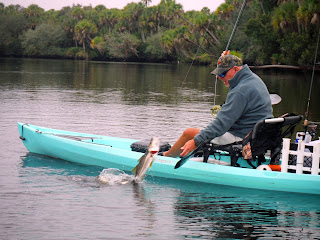 |
| Dr. John Lacy of Kentucky shows off one of the eight snook he caught on MirrOlure Lil Johns. |
With unseasonably warm weather, it was no surprise that snook
ruled during February. Southern Drawl Kayak Fishing clients landed snook to 30
inches on fly and spin gear while fishing around lighted docks and in the
Longboat Key rim canal.
 |
| Jon Freyer battles an Alligator Alley oscar on fly rod. |
We also encountered good numbers of spotted seatrout on fly
and spin gear in Sarasota Bay over deep grass patches off Whale Key.
Tim Foster, a winter resident from Montana, caught 20
spotted seatrout and a few ladyfish on my new glass minnow fly. He also lost a
couple of snook on a very windy day.
I spent a day at the Florida Sportsman Show in Fort Myers,
helping out NuCanoe. I demonstrated how to fly fish from a NuCanoe Frontier.
The NuCanoe Frontier and Pursuits are no doubt the best kayaks for fly fishing
on the market.
After fishing with me, Foster sold his paddleboard and
bought a NuCanoe Pursuit from West Coast Kayaks in St. Petersburg. One outing
is all it took to convince him that the Pursuit was the boat he needed for fly
fishing!
I spent a day fishing around Buttonwood Harbor with good success.
I caught 10 snook on fly and jigs. In addition, I landed 30 trout to 24 inches,
pompano and ladyfish.
 |
| Annie Ewert puts the pressure on a big fish. |
I accompanied about 20 members of the Mangrove Coast Fly
Fishers on an expedition to Alligator Alley for a two-day outing. Fly fishing
was great and everyone caught more oscar, Mayan cichlid, largemouth bass,
stumpknocker and warmouth perch than they could count.
After we got back from Alligator Alley, I demonstrated how to
fly fish from the NuCanoe Pursuit at the Mangrove Coast Fly Fishers Casting
Clinic at The Meadows in Sarasota. Members were very interested in the boat.
Tim Foster fished with me again and did fair despite strong
wind. He landed two snook, five spotted seatrout and ladyfish.
Repeat clients Al Ewert of Connecticut and daughter Annie of
New Hampshire caught 25 spotted seatrout, ladyfish and flounder on fly and spin
around Buttonwood Harbor.
 |
| Fly fisher Tim Foster stands and battles a spotted seatrout. |
Tom Biondo of Bradenton fished with me at Lake Manatee and
had an interesting day. New to fishing, Biondo caught large bluegill and
speckled perch on nymphs under a strike indicator. In all, we totaled eight specks,
15 bluegill and a largemouth bass.
Jim Doughton of Gainesville and Dr. Pete Gearan joined me
for a windy day of fly fishing around Buttonwood Harbor. They managed spotted
seatrout and ladyfish on my new glass minnow fly. In addition, they used the outing
to test out the NuCanoe Pursuit and Frontier.
Dr. John Lacy of Kentucky fished with me again and had an
exceptional day. He caught eight snook
to 27 inches on MirrOlure Lil Johns on light jigs. He also landed spotted
seatrout to14 inches, flounder to 15 and ladyfish on jigs and MirrOlure
MirrOdines.
Longtime fried Jon Freyer of Ludington, Mich., visited
Alligator Alley for the first time and came away impressed. He caught the
usual: oscar, Mayan cichlid, largemouth bass, bluegill and stumpknocker on
Myakka Minnows. He caught more fish than he could count.
Fly fishing along Alligator should remain strong through
May.
MARCH FORECAST: We
anticipate continued excellent action on spotted seatrout and snook. In
addition, redfish activity should be good on the flats around Sarasota Bay.
Night fishing for snook will continue to be excellent on fly and spin gear. In
fresh water, Lake Manatee should produce decent amounts of hand-sized bluegill,
large speckled perch, largemouth bass, shellcracker and channel catfish.
Expeditions to Alligator Alley will result in oscar, Mayan cichlid, largemouth
bass, bluegill and stumpknocker.
As usual, I'd like to thank my great sponsors: NuCanoe,
MirrOlure, D.O.A. Lures, TFO Fly Rods and Peak Fishing. They all play an
important part in the success of Southern Drawl Kayak Fishing.
If you'd like to spend a day on the water, please give me
call (941-284-3406) or email me (steve@kayakfishingsarasota.com).
Steve Gibson
Southern Drawl Kayak
Fishing
www.kayakfishingsarasota.com
941-284-3406
































